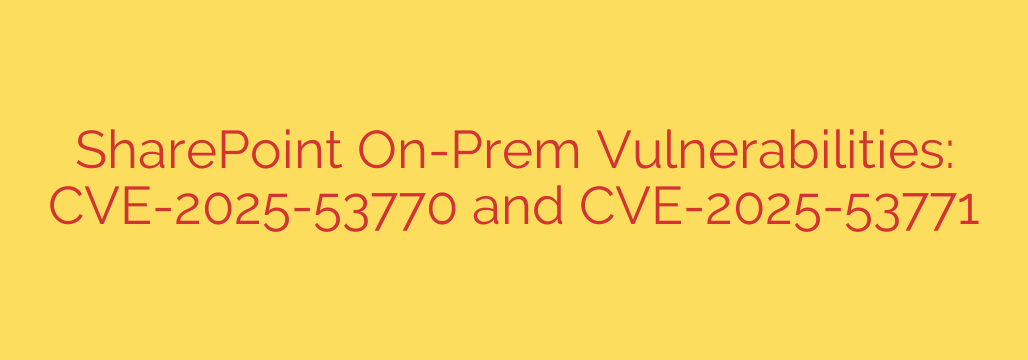
Critical SharePoint On-Prem Vulnerabilities Uncovered: Your Action Plan for CVE-2025-53770 and CVE-2025-53771
Administrators of on-premises SharePoint environments must take immediate action following the discovery of two significant security vulnerabilities. Identified as CVE-2025-53770 and CVE-2025-53771, these flaws pose a direct and serious threat to the security and integrity of unpatched servers.
These vulnerabilities affect self-hosted SharePoint deployments and require urgent attention to prevent potential exploitation by malicious actors. Understanding the nature of these threats and implementing the necessary security updates is critical for protecting your organization’s data and infrastructure.
A Closer Look at the New SharePoint Vulnerabilities
To effectively mitigate the risks, it’s essential to understand what each vulnerability entails. Both are severe, but they represent different attack vectors that could be used independently or chained together for a more devastating impact.
CVE-2025-53770: Remote Code Execution (RCE) Flaw
This is the more severe of the two vulnerabilities. A Remote Code Execution flaw allows an authenticated attacker to run arbitrary code on the SharePoint server. In simple terms, a bad actor who has gained access to your network—even with low-level credentials—could potentially take complete control of the server. This includes the ability to install malware, steal or modify sensitive data, and use the compromised server as a launchpad for further attacks within your network.
CVE-2025-53771: Privilege Escalation Risk
The second vulnerability allows for Privilege Escalation. This means a user with limited permissions could exploit the flaw to gain higher-level privileges, potentially becoming a farm administrator. An attacker could use this to bypass security controls, access restricted content, and grant themselves unauthorized administrative rights, making it much easier to conceal their activities and establish a persistent presence in your environment.
Which SharePoint Versions Are Affected?
These vulnerabilities impact several recent versions of on-premises SharePoint Server. If your organization is running any of the following, you are at risk and must apply the corresponding security updates:
- SharePoint Server 2016
- SharePoint Server 2019
- SharePoint Server Subscription Edition
Importantly, SharePoint Online customers are not affected by these vulnerabilities. Microsoft manages the security and patching for its cloud-based services, so if your organization uses SharePoint through a Microsoft 365 or Office 365 subscription, no action is required on your part.
Immediate Steps to Secure Your SharePoint Servers
Time is of the essence. The existence of a public patch means that attackers will soon reverse-engineer it to develop exploits. Follow these steps immediately to protect your environment.
Apply the Latest Security Patches: Microsoft has released security updates to address both CVE-2025-53770 and CVE-2025-53771. This is the single most important action you can take. Prioritize the deployment of these patches across all of your SharePoint farms without delay.
Verify Successful Installation: After deploying the updates, do not assume they were installed correctly. Verify that the patch has been successfully applied on every server in your farm. Check the patch status in Central Administration and review installation logs for any errors.
Monitor for Suspicious Activity: If you were unable to patch immediately, it’s crucial to review server logs for any signs of compromise. Look for unusual processes, unexpected account privilege changes, or strange network traffic originating from your SharePoint servers.
The High Stakes: Why You Can’t Afford to Ignore These Patches
Failing to address these vulnerabilities leaves your organization exposed to severe consequences, including:
- Complete Server Compromise: An attacker could gain full control over your SharePoint server, effectively owning a critical piece of your IT infrastructure.
- Critical Data Breaches: SharePoint often stores sensitive business documents, intellectual property, and personal information. A breach could lead to massive data theft and severe regulatory fines.
- Ransomware Deployment: A compromised server is a perfect entry point for deploying ransomware, which could encrypt your entire SharePoint farm and spread to other systems on the network.
- Lateral Network Movement: Once inside, attackers can use the trusted SharePoint server to move laterally across your network, compromising other critical assets like domain controllers and databases.
Beyond the Patch: Long-Term SharePoint Security
While immediate patching is mandatory, use this event as an opportunity to strengthen your overall security posture.
- Enforce the Principle of Least Privilege: Ensure users and service accounts only have the permissions absolutely necessary to perform their roles.
- Maintain a Consistent Patching Cadence: Don’t wait for critical alerts. Implement a regular schedule for applying all security updates to keep your systems protected against future threats.
- Conduct Regular Security Audits: Proactively audit your SharePoint environment for misconfigurations, excessive permissions, and signs of unauthorized access.
- Segment Your Network: Isolate your SharePoint servers from other parts of the network where possible to limit the blast radius of a potential breach.
The discovery of CVE-2025-53770 and CVE-2025-53771 is a serious reminder that on-premises systems require constant vigilance. By taking swift and decisive action, you can protect your organization from these critical threats and ensure the continued security of your SharePoint environment.
Source: https://www.cybereason.com/blog/two-sharepoint-on-prem-vulnerabilities







